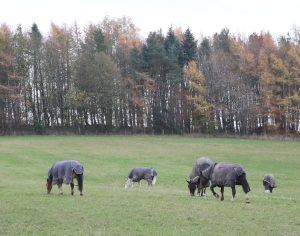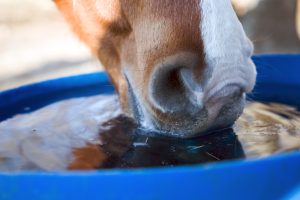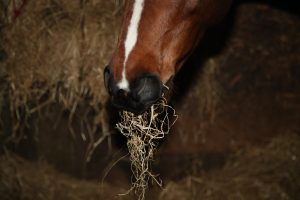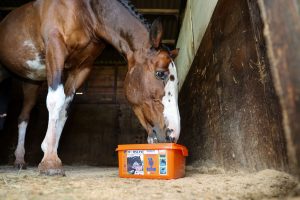Balancing the diet
Given that this week is Nutrition and Hydration week, Horslyx and partner, British Pet Insurance, thought it would be good to look at what a balanced diet should provide your horse. In feed stores of the 90s ‘balancers’ were not common but nowadays you’d be hard pushed to find a retailer without several options on their shelves. Why the change? If you are not feeding the recommended amounts of a mix or cube (and many aren’t), you won’t be providing a balanced diet and vitamins and minerals especially will be lacking.
Evolution is key!
A balanced diet will meet the nutrient requirements of the animal and maintain healthy digestion. Understanding the evolution of the horse as a trickle feeder of forages helps understand what a horse or pony requires in a balanced diet.
Horses have evolved to continuously roam over vast areas and graze, or ‘trickle-feed’ for 16–18 hours per day.  Today, horses are kept in relative luxury in comparison to their ancestors, but their digestive system is still similar, so a horse still needs this trickle-feed supply of nutrients to remain in optimum health.
Today, horses are kept in relative luxury in comparison to their ancestors, but their digestive system is still similar, so a horse still needs this trickle-feed supply of nutrients to remain in optimum health.
The digestive system starts with the mouth, chewing and licking releases saliva which helps to buffer stomach acidity. The horse’s stomach is the size of a rugby ball and is where the digestion starts, continues in the small intestine, and is completed in the hindgut. Two thirds of the equine digestive system is in the hindgut, and this is where the fermentation of fibre takes place by micro-organisms and beneficial bacteria.
When the hindgut is healthy and the horse is trickle-fed ample amounts of good quality forage, plus a balanced diet, the hindgut will provide the horse with warmth from fermentation of fibre and a range of B-vitamins which ensure that the horse’s skin and coat are healthy, and his hooves are in good condition.
What is a balanced diet?
There are several nutrients a horse requires to stay healthy: water, protein, carbohydrates, fats, vitamins and minerals. The specific amounts required of each varies depends on liveweight, workload and breed as well as physiological status (if the animal is growing or in foal). The NRC Nutrient Requirements of Horses has been determined from research over many years and provides information based on differing bodyweights along with a guide for Low, Medium or High requirements.
What to include?
 WATER
WATER
Water is the most important nutrient, but often overlooked. All horses should have access to clean, fresh water at all times, without it problems such as colic or dehydration could arise. A 500kg horse will drink approximately 30 – 45 l per day but this can vary depending on physiological state and diet: a horse eating hay will likely drink more than one eating fresh grass.
FIBRE
What horses have evolved to eat! Fibre sources include grass, hay and haylage  as well as short chopped fibres to name a few. The complex carbohydrates which provide dietary fibre to the horse are extremely important for digestive health and the good bugs in the hindgut are highly sensitive to alterations in the fibre supply.
as well as short chopped fibres to name a few. The complex carbohydrates which provide dietary fibre to the horse are extremely important for digestive health and the good bugs in the hindgut are highly sensitive to alterations in the fibre supply.
PROTEIN
Protein provides the building blocks (amino acids) required for muscle tissue synthesis. Some amino acids can be manufactured by the horse (called “non-essential” amino acids), others must be provided by the diet (“essential” amino acids) because they cannot be produced by the horse.
FATS
Oils are energy dense and a great source of slow-release energy. Some fatty acids can help in producing a glossy coat as well as boost the immune system. The equine can source Omega-6 from cereals but these are low in Omega-3, so horses need an additional source such as linseed oil to provide these fats.
MINERALS
Macro minerals are those needed in relatively large amounts, such as calcium, phosphorus, sodium, potassium, chloride, magnesium and sulphur and trace minerals are those needed in small amounts including cobalt, copper, zinc, selenium, iron and iodine. It is important to provide the correct balance of minerals as an excess of one mineral in the diet may affect the availability of another: over-supplementation of one may block absorption of another leading to a deficiency. Over-supplementation can also potentially lead to toxicity.
VITAMINS
Vitamins are classified as water soluble (A, D, E or K) or fat soluble (B-complex and C). Microbes in the hindgut synthesize the B-complex as a by-product of fibre digestion. In most cases this will meet most horse’s needs, however if hindgut balance is disrupted through stress or illness, they will take time to recover, and these vitamins can be supplied through the diet.
STARCH
Starch is a major component of cereal grains and as a complex carbohydrate requires breakdown into simple sugars to be absorbed efficiently. Horses only produce limited amounts of amylase, the enzyme which breaks down starch and this can cause some issues leading to digestive or metabolic disorders such as colic or tying up and disturbing the hindgut microbiome. Starch is a useful nutrient when the levels of workload require a higher energy than fibre alone can contribute but must be used carefully.
Getting it wrong…
In extreme circumstances feeding an imbalanced diet can lead to illness, however in reality it will be much more subtle. Hooves may be crumbly, flaky, maybe abscesses, their skin will be dull, the coat won’t shine, droppings may be loose, and they are likely to be a bit flat when ridden.
What does a Balancer look like?
Balancers are available in various formats: pellets, powder or lick which will provide that balanced diet.  Pellets can be fed by hand or added to a bucket feed, powder needs to be mixed into a bucket feed with a ‘carrier’ such as a fibre feed, a mix or soaked sugar beet and a lick such as Horslyx Balancer can be made available 24/7 to allow that trickle feeding pattern as nature intended.
Pellets can be fed by hand or added to a bucket feed, powder needs to be mixed into a bucket feed with a ‘carrier’ such as a fibre feed, a mix or soaked sugar beet and a lick such as Horslyx Balancer can be made available 24/7 to allow that trickle feeding pattern as nature intended.
Horslyx Balancers have been carefully formulated to balance the deficiencies in forage and grazing. They contain an optimum level of vitamins, minerals and trace elements in one easy to use, cost effective tub. They promote a natural trickle feed pattern that allows the horse to self-regulate and consume Horslyx as and when they need it, so in most cases you just have to make sure you provide ample, good quality forage and clean fresh water! Job done!

